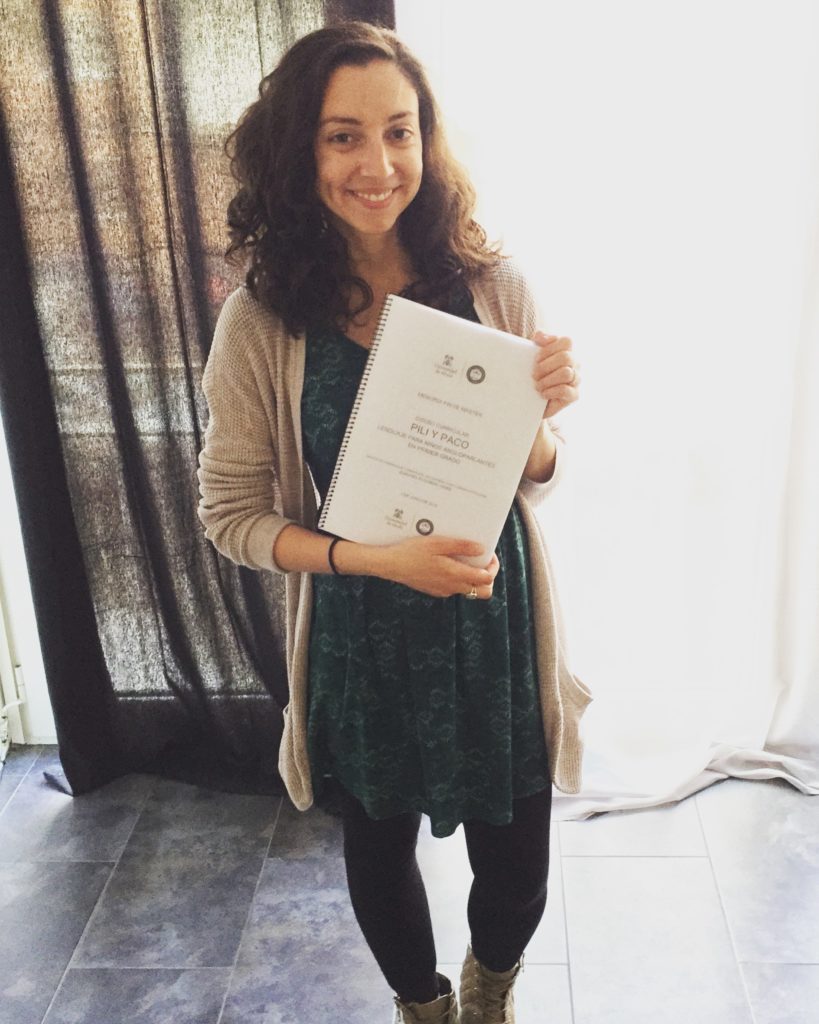Fellow ELE-ers, let me tell you a secret: writing a thesis in Spanish isn’t as hard as you think.
I was able to write my thesis and enjoy it. I loved my topic and I had fun developing the ideas and supplementary materials. Once I got started and made a plan, it wasn’t anywhere near as tough as I expected it to be.
Yes, writing a thesis in your own language is daunting. And yes, writing one in Spanish is even more of a challenge. But it’s not as panic-inducing as it seems.
In fact, it’s far easier once you’re “in it.”
So, start off by changing your whole mindset. Don’t procrastinate. Don’t panic unnecessarily. Don’t dread writing before you even get started.
Instead, take it step by step. Look at it as another routine assignment. Don’t think about it when you don’t have to. And follow some of my tips below to make your life a little easier.
 The writing setup
The writing setup
Photo courtesy of the author
Put Your Blinders on to the Other Programs
This causes major panic every year: ELE students become aware of thesis deadlines and requirements for the other Teach & Learn Master’s programs and think those deadlines and requirements apply to them too. They don’t.
The ELE program does its own thing. Follow your thesis advisors instructions and then read the multiple emails that detail what you need to do.
Choose a Thesis Topic You Love
This applies to any thesis in any language. But especially for ELE students who are already bogged down by writing in another language, you’ll want to make everything else easier.
I created a curriculum design for teaching Spanish Language Arts to first graders in Texas. Why? Because before I started my Master’s I was a bilingual first grade teacher in Texas and Language Arts was my favorite subject.
I not only chose what I loved, but also what I knew, and what I could use in the future. I was already an “expert.” I had tons of ideas that I wanted to piece together from my experience with different teaching models and theories. In my thesis, I created my ideal curriculum.
Again, because this bears repeating: Choose what you love, choose what you know, and choose something that will help you in the future.
Be Present in Your Classes
Put your phone down and listen.
I know a five-hour class on a Friday can be mind-numbing at times. I get that. But as an ELE student, if you aren’t paying attention you’re going to miss out twice as much.
Just like any class, you’re there to learn the content. But unlike your friends in other programs, you also need to learn and/or brush up on your academic Spanish. You’ll need that higher level of Spanish to write a solid thesis.
That means do your readings and listen to the way your professors speak. Analyze and absorb as much of that academic vocabulary and phrasing as you can. Implement it in your assignments and then write a next-level thesis that communicates your ideas clearly and effectively.
Find a Good Spanish Dictionary
My favorite is Linguee because you can search a word and see how it’s translated in a variety of different contexts.
Another extremely important resource is the Real Academia Española, the official governing body for the Spanish Language, as well the Fundeu BBVA where you can use their “Consultas” page to look up or submit specific language questions.
Bookmark these, you will use them a lot.
Use Class Assignments for Your Thesis
Don’t do double the work. You will have a few final projects for your classes throughout the year that can serve as both your final project and then be integrated (with a little tweaking) into your thesis. Work smarter, not harder.
Break it Down into Small Sections
You will be given a thesis outline to follow and all the sections that need to be included. Work on your thesis section by section. This breaks it up into small, manageable pieces.
Don’t feel the need to finish each section in order. Work on your thesis in the order that makes sense to you.
You can easily jump between sections by using programs like Google Docs. It allows you to create an outline, visible in a sidebar to the left of your screen, and select whichever section you need that day. I mention Google Docs because it’s free, but any program that you are familiar with and has this capability will make for less stressful thesis writing.
Finish Early
And then get someone to read over your thesis.
That someone should absolutely be a native Spanish speaker with a good command of grammar. Beyond that, it was highly suggested to us that our proofreader be a person who also has some knowledge of teaching. That will make it easier for them, as they read over certain educational jargon that may not be understood by someone outside of the field of education.
I finished my thesis a month early (because I’m a nerd). And while I don’t think it’s necessary to finish that early, it is a good idea to give yourself, and your proofreader, some extra time. I was able to send along one section at a time after I had edited and proofread it myself. It made it far less overwhelming for the both of us.
Choosing a Proofreader
Start the search early for anyone that you think might be willing to help. Asking around at your placement school is your best, and easiest, option. But, if you can’t find any takers you might need to consider paying someone (maybe in drinks, a meal, or actual cash). I really dislike mentioning this, because free is always in your budget, but if you get desperate, it’s an option.
Keep in mind that your proofreader is just reading over for phrasing and grammar. You will need to make sure that the copy you send them is cleaned up to the best of your ability. They are doing you a huge favor, but they are not there to fix simple mistakes.
 The finished, printed, and bound work!
The finished, printed, and bound work!
Photo courtesy of the author.
Celebrate
Once you’re finished – and you will finish – remind yourself how huge of an accomplishment this is. Celebrate, enjoy, go nuts, and share your achievement on your social media of choice. This is a huge deal and there’s no shame in sharing that with the world.
You’ve got this, fellow ELE-ers. I promise.
Jennifer Ruggiero Webb

Jennifer is originally from New York State and has over eight years of experience teaching in bilingual elementary schools in Spain and Texas. She fell in love with Spain while studying abroad in Seville and has periodically found her way back ever since. In 2018, she received a Masters in Teaching Spanish as a Foreign Language with Instituto Franklin. She still lives in Alcalá with her husband (also an Instituto Franklin alumni), their daughter, and their dog. You can read some of her other writing on her blog, Bilingually Yours.

